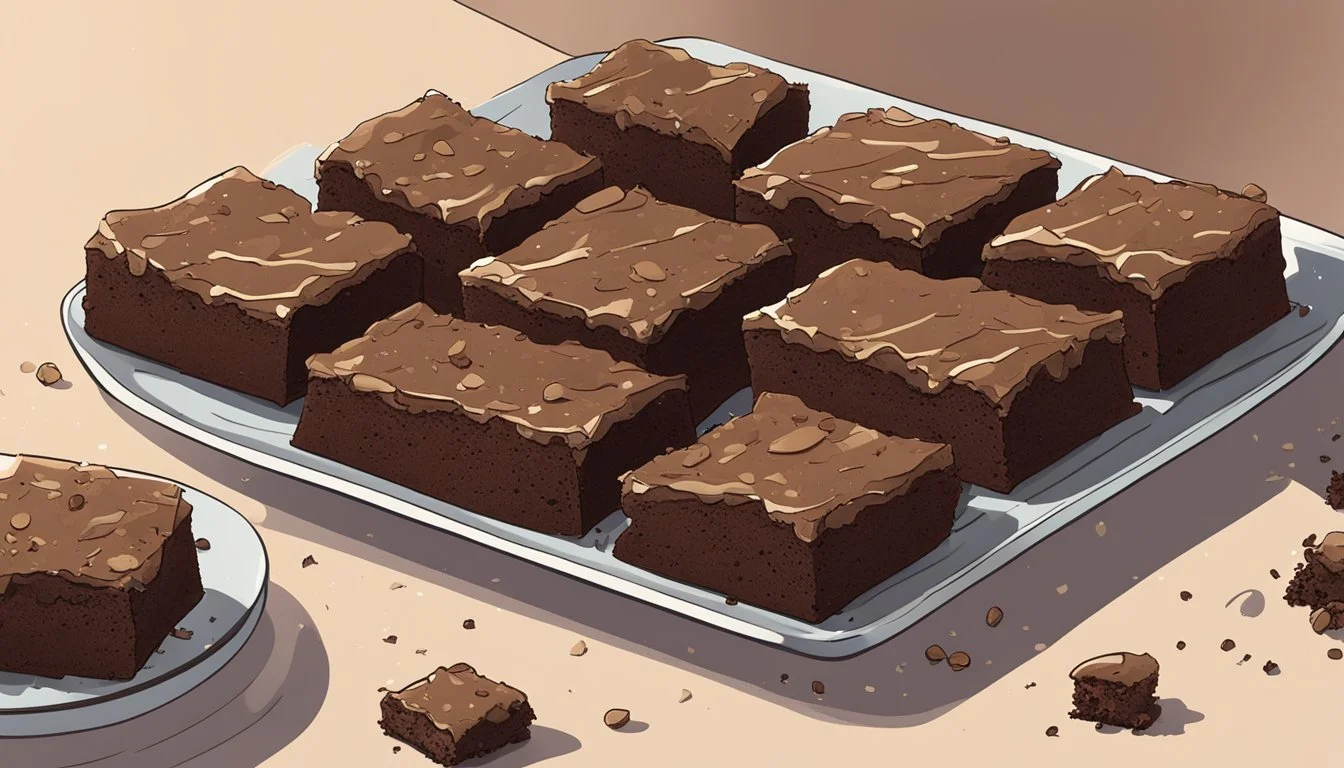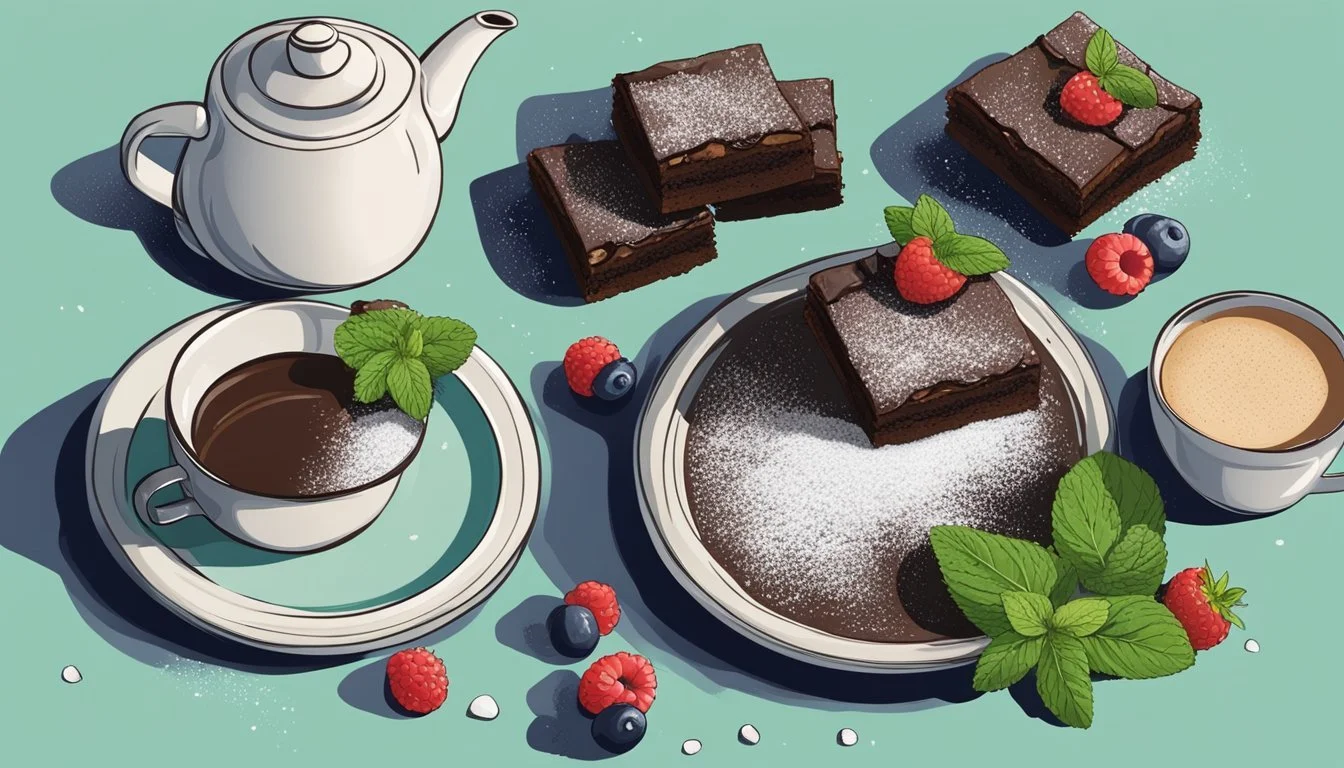How Long Do Gluten-Free Brownies Last?
Shelf Life and Storage Tips
Gluten-free brownies, like their traditional counterparts, have a shelf life that varies depending on storage conditions. When stored at room temperature in an airtight container, gluten-free brownies generally last 3 to 4 days. Proper refrigeration can extend their freshness up to a week, while freezing can preserve them for several months.
Quality and flavor are best maintained when the brownies are stored correctly. Keeping them in a cool, dark place in a tightly sealed container can prevent them from drying out and losing their rich, fudgy texture. For those who want to enjoy their gluten-free brownies for even longer, individual wrapping and freezing are excellent options.
Texture and moisture play significant roles in defining the longevity of these treats. The inclusion of ingredients like xanthan gum and cornstarch can help maintain the structure and moisture, making the brownies enjoyable for a more extended period.
Understanding Gluten-Free Brownies
Gluten-free brownies are a popular treat for those avoiding gluten. The ingredients and preparation methods can significantly affect their texture and taste, from fudgy to cakey to chewy.
Definition of Gluten-Free
Gluten-free brownies are baked goods that do not contain gluten, a family of proteins found in wheat, barley, and rye. These proteins cause an adverse reaction in individuals with celiac disease or gluten intolerance. To meet gluten-free standards, brownies must be made with alternative flours like almond flour or gluten-free all-purpose flour, which typically includes a blend of rice flour, potato starch, and tapioca flour.
Key Ingredients in Gluten-Free Brownie Recipes
Gluten-Free Flour: The primary substitute for wheat flour. Common options are rice flour, almond flour, and ready-made gluten-free flour mixes often combined with xanthan gum to mimic gluten's binding properties.
Cocoa Powder: Provides the essential chocolate flavor. Both natural and Dutch-processed cocoa powder can be used based on the desired taste profile.
Eggs: Serve as a binding agent and can be replaced with alternatives like a flax egg for a dairy-free version.
Sugar: Typically, a mix of granulated sugar and brown sugar is used to achieve the right sweetness and moisture content.
Additional Ingredients: Vanilla extract enhances flavor, while salt balances sweetness. Optional ingredients like chocolate chips can be added for extra fudginess.
Comparing Textures: Fudgy vs. Cakey vs. Chewy
Fudgy: Achieved by adding a higher fat content, often through butter or additional chocolate. Fudgy brownies have a dense, rich texture and typically include more chocolate chips or melted chocolate.
Cakey: More flour and a leavening agent like baking powder or baking soda create a lighter, airier texture. These brownies resemble a cake more than a typical dense brownie.
Chewy: A balance between fudgy and cakey. They often include a combination of granulated and brown sugar, which adds moisture and contributes to the chewy texture. The inclusion of ingredients like cornstarch may also help achieve this consistency.
Understanding these elements helps in crafting the perfect gluten-free brownie, tailored to individual texture and taste preferences.
Creating the Perfect Gluten-Free Brownie
Crafting the perfect gluten-free brownie involves selecting quality ingredients, achieving the right consistency, incorporating alternatives for various dietary needs, and utilizing effective mixing methods. Each factor plays a vital role in ensuring the brownies are as delicious and satisfying as possible.
Selecting the Right Gluten-Free Flour Blend
The choice of flour blend significantly impacts the texture and taste of gluten-free brownies. Gluten-free flour blends often contain a mix of rice flour, potato starch, and tapioca flour. It’s essential to choose a blend that includes xanthan gum or guar gum to mimic the elasticity of gluten.
For a richer chocolate flavor and moist texture, some bakers recommend blends that include almond flour or coconut flour. However, these flours can affect the density and moisture level, so adjustments in other ingredients may be necessary.
Achieving Desired Brownie Consistency
The consistency of gluten-free brownies can range from cakey to fudgy. Common ingredients that influence texture include butter or oil and mix-ins such as chocolate chips.
For fudgy brownies, increase the fat content by using more butter or adding melted chocolate to the batter. A one-bowl method can help keep the brownies dense and moist. Conversely, for a cakier texture, incorporating more baking soda or baking powder along with extra eggs can yield a lighter, airy result.
Alternative Ingredients for Dietary Needs
Gluten-free brownies can be customized to meet various dietary restrictions. For vegan or vegetarian brownies, substitute eggs with ingredients like flax meal or chia seeds. Dairy free options involve using olive oil or coconut oil instead of butter.
For those with nut allergies, avoid almond flour and instead use gluten-free all-purpose flour. Including mix-ins like dairy-free chocolate chips can enhance the flavor without compromising dietary requirements.
Mixing Methods to Enhance Gluten-Free Brownie Recipes
How the ingredients are mixed also affects the final product. Whisking melted butter with sugar until light can create a smooth base. Sift dry ingredients such as cocoa powder, baking soda, and gluten-free flour together to ensure even distribution.
Using a rubber spatula to gently fold in dry ingredients into wet ingredients helps prevent overworking the batter, which can make the brownies tough. Timing matters too; mixing just until combined is key to maintaining a tender crumb in the brownies.
By carefully selecting ingredients and following precise mixing techniques, anyone can create delicious, gluten-free brownies that will satisfy even the pickiest eaters.
Storing and Preserving Gluten-Free Brownies
To maintain the freshness and extend the shelf life of gluten-free brownies, proper storage techniques are crucial. Consider these tips for optimal storage conditions, freezing methods, and shelf life considerations.
Optimal Storage Conditions for Freshness
Store gluten-free brownies in an airtight container to prevent them from drying out. Placing a slice of bread in the container can help maintain moisture.
Use parchment paper to layer the brownies, preventing them from sticking together. Choosing between a metal pan or glass pan depends on personal preference, but both work well. If storing in the pantry, ensure it’s a cool, dry place; brownies typically last 3-4 days at room temperature.
Freezing and Thawing Gluten-Free Brownies
To freeze the brownies, wrap each piece tightly in aluminum foil or plastic wrap to avoid freezer burn. Place the wrapped brownies in a freezer-safe, airtight container.
When ready to eat, thaw them by leaving them at room temperature for several hours or overnight. This method preserves the texture and flavor of gluten-free brownies. Coconut oil or salted butter in the recipe may impact the thawing time slightly but generally, this process keeps the brownies tasting fresh.
Shelf Life Considerations
Homemade gluten-free brownies typically last 3-4 days at room temperature. Placing them in the refrigerator can extend their shelf life up to a week.
For longer storage, freezing is the best option, keeping them safe for up to 3 months. Be mindful of the ingredients used, as some, like unsalted butter, might affect longevity. Brownies ordered online may have different shelf lives due to preservatives and should be checked individually.
Presentation and Serving Suggestions
When serving gluten-free brownies, consider not only how they look but also how they pair with other foods or drinks. Proper cutting techniques and creative serving ideas can enhance the overall experience.
Cutting and Serving Gluten-Free Brownies
To cut gluten-free brownies neatly, it's best to use a serrated knife. This helps prevent crumbling and ensures clean edges. For a smoother cut, dip the knife in hot water before slicing. Using a toothpick can help check if the brownies are fully baked: insert it into the center, and it should come out mostly clean.
When serving, consider portion sizes. Bite-sized pieces are great for parties, while larger squares suit individual desserts. Line the serving platter with parchment paper to prevent sticking.
Creative Serving Ideas
Transform your gluten-free brownies into delightful desserts with simple add-ons. Create a brownie sundae by topping a warm brownie with a scoop of ice cream, whipped cream, and a drizzle of chocolate sauce.
Add a layer of frosting or vegan butter for extra indulgence. For a crunchy twist, sprinkle chopped nuts on top before baking or as a garnish. Presentation matters: serve brownies on elegant plates or creative stands for a lovely display.
Pairings and Combinations
Pair gluten-free brownies with the right foods to elevate the experience. Fresh berries, like strawberries or raspberries, add both color and a tart contrast. Nuts like walnuts or pecans bring a satisfying crunch.
For a beverage pairing, consider a rich cup of coffee, a glass of milk, or even a full-bodied red wine. Vegetarian and vegan brownie recipes can be paired with dairy-free milk alternatives like almond or oat milk. These thoughtful combinations will please a diverse crowd and enhance the flavor profile of your brownies.
Troubleshooting Common Gluten-Free Brownie Challenges
Achieving the perfect gluten-free brownie can be challenging due to texture issues and the risk of them drying out. Below are specific tips to address these common problems.
Dealing with Texture Issues
Texture is a key concern in gluten-free baking. Many gluten-free brownies crumble easily or lack the desired fudgy texture. Cornstarch can be added to the gluten-free flour mix to provide structure without making the brownies too dense.
It's important not to overbake the brownies, as even a few extra minutes can turn them crumbly. Monitoring baking time closely and checking for doneness with a toothpick can help achieve the right consistency.
For a flaky crust on top, whisking the eggs and sugar thoroughly can help. This process aerates the batter and creates a characteristic thin crust. Pre-whipping the eggs may also improve the overall texture.
Preventing Brownies from Drying Out
Dry brownies are often a result of overbaking or incorrect ingredient proportions. Ensuring the batter has sufficient moisture is key. Adding ingredients like a bit of milk or extra egg yolk can enhance moisture retention.
Storing the brownies correctly is crucial to maintain their moisture. Keeping them in an airtight container at room temperature can help preserve their texture and prevent them from drying out. Alternatively, wrapping individual pieces in plastic wrap before placing in an airtight container maximizes freshness.
Another tip is to avoid cutting all the brownies at once. Keeping the brownie slab whole and cutting pieces as needed can help retain moisture, ensuring each bite stays fresh and fudgy.
Exploring Variations and Specialities
There are various ways to make gluten-free brownies unique and cater to specific dietary needs. Some of the most interesting variations include those that adapt to special diets and incorporate different flavors and add-ins. Below, we will examine these techniques in more detail.
Gluten-Free Brownie Variations
Gluten-free brownies can be customized in numerous ways to fit personal preferences or dietary restrictions. Espresso powder can be added to enhance the chocolate flavor, creating a richer taste. Adding textures like pecans or coconut flakes can make brownies more interesting.
Some recipes use substitutes like flax eggs instead of regular eggs, making the brownies both gluten-free and vegan. Incorporating different types of chocolate such as milk chocolate chips or white chocolate chips can also change the flavor profile.
Special Diet Adaptations
For those on a dairy-free diet, dairy-free brownies are an excellent option. Ingredients such as vegan chocolate chips and nut milk can be used to replace dairy products.
Vegan options can use flax eggs or other plant-based egg substitutes. Gluten-free brownies can also cater to individuals avoiding specific allergens, ensuring everyone can enjoy a delicious treat without compromising their dietary needs. Necessary equipment like mixers can help achieve the best texture in these adaptations.
Incorporating Different Flavors and Add-Ins
Adding different flavors and inclusions can make gluten-free brownies stand out. For example, blending in flavors like mint, orange zest, or even peanut butter can add a unique twist. Add-ins can vary from chocolate chunks to dried fruits, providing a burst of flavor and texture.
Some recipes include pouring the batter into the pan, adding a swirl of caramel or berry preserves, giving each bite a delightful combination. By experimenting with various flavors and add-ins, gluten-free brownies can become a customizable and exciting dessert option for any occasion.
Wrap-Up and Final Tips for Making Gluten-Free Brownies
Using quality ingredients like coconut sugar or white sugar enhances the flavor.
Opt for a metal baking pan for even heat distribution. This ensures chewy edges and a fudgy center.
Avoid overbaking to maintain moisture. A toothpick inserted should come out with a few crumbs.
Store properly to extend freshness. Keep in an airtight container at room temperature for up to three days.
Experiment with replacements. Try almond flour brownies or even flourless brownies.
Incorporate pantry staples like vanilla and kosher salt for a balanced taste. These essentials enhance natural flavors.
Don't overlook the type of sweetener. Coconut sugar can add depth while white sugar gives a classic taste.
Creating homemade brownies allows control over dietary preferences, ensuring they are truly gluten-free.
Consider variations like sweet potato brownies for a nutrient boost. These alternatives add a unique twist.
These tips aim to perfect both flavor and texture in gluten-free brownies while making the process enjoyable and flexible.









